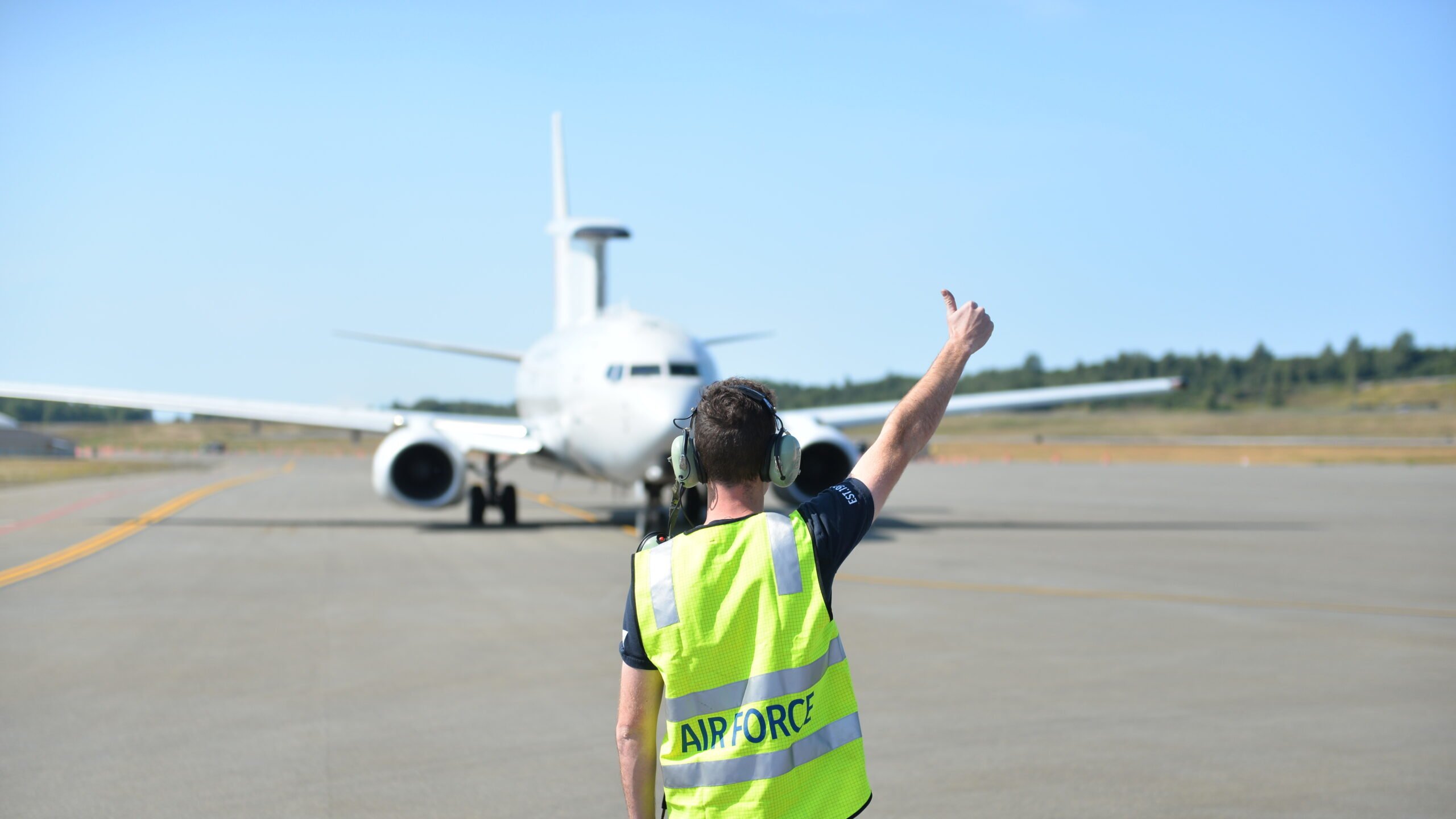
Royal Australian Air Force Leading aircraftman Peter Ellis gives the thumbs up that the E-7A Wedgetail airborne early warning and control aircraft is ready for a sortie during Red Flag-Alaska 19-3 at Joint Base Elmendorf-Richardson, Alaska, Aug. 9, 2019. (US Air Force/2nd Lt. Mark Goss)
WASHINGTON: The Air Force is looking for opportunities to expedite its planned acquisition of Boeing’s E-7 Wedgetail, but it may not be possible to get the first prototype before fiscal 2027, the service’s top civilian said Tuesday.
Last week, the Air Force announced that it would purchase the Wedgetail, but that it could take as many as five years for the first aircraft to be delivered to the service — a time estimate for a plane that’s already in allied service that has many lawmakers questioning if the Air Force can move faster.
One major problem, according to Air Force Secretary Frank Kendall, is that once the Air Force inks a contract for the Wedgetail in FY23, it could be stuck at the back of the line waiting for Boeing 737-700NG business jets that can be reconfigured into a militarized early warning and control plane.
“The timeline is driven by the fact that we’re buying new commercial airplanes and then modifying them to be the surveillance platforms that we want,” Kendall told the Senate Armed Services Committee on Tuesday. “Getting the airplanes is about a two-year process, and then modifying them is another two-year process. There are things that we could do, however, to maybe get access to aircraft earlier one way or another.”
Boeing ended commercial production of the 737 NG in 2020, but it continues making the airliner for customers of military derivative aircraft such as the E-7 — which is currently being purchased by the United Kingdom and is already in use in Australia — and the US Navy’s P-8 Poseidon sub hunting aircraft.
Kendall hinted that the Air Force could seek to work with Boeing and other 737 NG customers to get the jets earlier, saying that options to expedite procurement “are going to require some changes by people who we don’t necessarily have control of, in terms of their priorities.”
When Kendall spoke to lawmakers during Tuesday’s SASC hearing and in an April 26 hearing of the House Armed Services Committee, lawmakers questioned why it would take the Air Force five years to buy an aircraft that is currently under production.
“Can we wait that long, given the pacing threat of China, particularly?” asked SASC chairman Jack Reed, D-R.I.
Another complicating factor is the Air Force’s current plan to retire 15 E-3 Sentry Airborne Warning and Control System (AWACS) planes in FY23, a move that raised concerns from Congress about a capability gap between the retirement of the E-3 fleet and the standup of the first E-7 squadrons. Kendall said on April 27 that the divestment would save about $1 billion per year.
SASC Ranking Member Jim Inhofe — who represents Oklahoma, which is home to Tinker Air Force Base where 28 AWACS are based — indicated he would be in favor of putting the E-7 on contract in FY22 if possible, saying “I think all of us agree we need to get the E-7 as fast as possible for the high-end fight.”
The Air Force plans to buy a modified version of the United Kingdom variant of the Wedgetail, which will be equipped with US-specific capabilities such as Mobile User Objective System communications, M-Code GPS, and additional cyber hardening and anti-tamper features, said Air Force spokeswoman Capt. Samantha Morrison said in response to questions from Breaking Defense.
However, the service does not believe the US-specific upgrades will impact the delivery schedule, as the primary driver of the E-7’s “complicated and lengthy” build process is the structural modification work necessary for all customers to add the electronically scanned array radar to the top of the aircraft.
The Air Force intends to purchase at least 18 E-7 aircraft for an estimated cost of $9.9 billion, Morrison said. That would replace less than two thirds of the existing inventory of AWACS aircraft, which currently numbers 31 planes.
Morrison noted that the service “is continuing to evaluate [the] total fleet size required” to replace the E-3, which could leave the door open to buying additional E-7s.
Boeing announced to its workforce today that it will build the Air Force’s first two E-7s in Puget Sound, Wash., where production of UK E-7s is currently ongoing.
“This supports the Air Force’s priority on accelerated schedule and low risk development by collocating the design, certification and modification effort,” Boeing said in a statement to Breaking Defense. “It also leverages the commercial derivative aircraft design, certification, and modification capabilities already in place in Puget Sound, including critical skills and infrastructure.”
The Air Force requested $227 million in FY23 to purchase the first Wedgetail prototype. A second prototype is set to be purchased in FY24, with a production decision occurring in FY25.
Move over FARA: General Atomics pitching new Gray Eagle version for armed scout mission
General Atomics will also showcase its Mojave demonstrator for the first time during the Army Aviation Association of America conference in Denver, a company spokesman said.


























